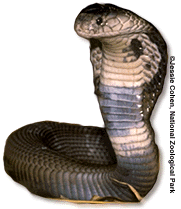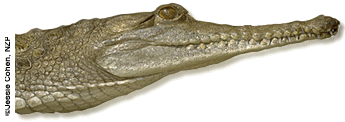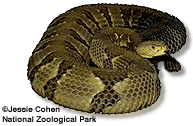| Essay, part 1 Introduction Essay, part 2 Who's a Herp? Essay, part 3 Our Views of Herps Essay, part 4 Herps Need Our Help |
Our Views of Herps – Present and Past 
Remember when Indiana Jones drops into a room full of writhing snakes? It was a memorable scene from the movie Raiders of the Lost Ark, designed to elicit visceral gasps of fear and revulsion. And it's one of the best examples of something screenplay writers and others have known for a long time: snakes and certain other herps have great "horror appeal." The more movies and other media portray herps as creepy creatures, the more people think of them that way.
Creature Features
Even before herps became typecast as horror-flick villains, they suffered from a fundamental image problem. Most reptiles and amphibians just don't have the cute and cuddly qualities of mammals or the graceful beauty of birds. In fact, many herps seem almost alien, and therefore it's difficult for people to relate to them. We tend to dislike and fear that which is different from ourselves and – even though herps have much more in common with us than many people realize (see Herps and Humans ) – they certainly look different. Picture a snake with its long, limbless body and glassy eyes; a toad with its warty skin; an alligator with its huge, gaping jaws. Remind you of any sci-fi films about creatures from other planets?
The Threat of Danger
Another factor working against the popularity of herps is that some of them are poisonous. It is true that certain herps produce some of the most toxic substances found in nature, but only a relatively small number of herps pose a threat to people. For example, fewer than 10 percent of snakes have venom that can hurt a human. Still, many people are afraid of all herps and assume that anything slithery, slimy, or scaly is either venomous or dangerous in some other way.
 Crocodile
Mummies and Sacred Snakes
Crocodile
Mummies and Sacred Snakes
Ironically, this basic fear of herps may have a lot to do with the positions of honor they've held in different cultures around the world. Throughout history, people deified those herps they viewed as a threat – probably in an effort to appease the animals and therefore lessen the damage they caused. Crocodiles, powerful predators that are known to claim the lives of careless swimmers and bathers, were sacred animals in ancient Egypt. Their mummified remains are evidence of the respect Egyptians paid these animals. Cobras were also worshipped in ancient Egypt; in India and other Hindu cultures, these snakes are still considered sacred.
Living Symbols
Some herps, including many harmless species, were valued for their symbolic significance. Consider the tortoise, an animal with a reputation for longevity as some can live more than 100 years. In ancient Japan, wedding gifts portraying tortoises were the givers' way of wishing the newlyweds a long and happy life together.
The perception of what an animal represents isn't necessarily universal, though. For example, what comes to mind when you think of a frog? To many people, frogs are just lowly little creatures that live in swamps. But some cultures view them differently. Because of their close ties to life-giving water, frogs have been seen as symbols of fertility, birth, and crop growth. For example, the Mayans believed that a frog named Uo was responsible for the coming of rain. When the rain god heard Uo's call, he would sprinkle water from his gourd onto the Earth.
 Links with the Underworld
Links with the Underworld
Opinions of herps took a turn for the worse in Judeo-Christian traditions. For example, the Bible tells of a plague of frogs that overtook the city of Ramses. But the Bible's most sinister portrayal of herps is the serpent in the garden of Eden – a scaly manifestation of evil from the underworld.
Actually, snakes had been associated with the underworld in non-Judeo-Christian traditions for eons. But this association wasn't necessarily considered evil. The world beneath the Earth's surface was the realm of Earth deities, and snakes, with their underground dens and ground-hugging locomotion, were thought to have connections to these powerful beings. Their link to the gods and goddesses of the Earth meant that snakes were creatures deserving of humans' respect.
